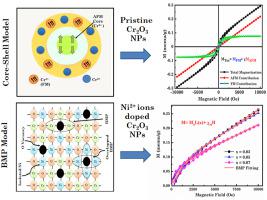Solid State Sciences ( IF 3.5 ) Pub Date : 2021-03-05 , DOI: 10.1016/j.solidstatesciences.2021.106581 Pankaj Bhardwaj , Jarnail Singh , Rajesh Kumar , Ravi Kumar , Vikram Verma

|
In this present investigation, we have performed a systematic study to determine the suitability of chromium oxide (Cr2O3) as diluted magnetic oxide (DMO). Pristine Cr2O3 and Ni2+ ion-doped nanoparticles synthesized via a cost-effective, simple co-precipitation method. XRD studies with Raman and FT-IR confirm that Cr2O3 nanoparticles with Ni2+ ions doping exhibiting rhombohedral structure without the presence of any secondary phase. The TEM micrographs confirm the formation of highly crystalline pristine and Ni2+ ions doped Cr2O3 nanoparticles, whereas SAED and HRTEM confirm the rhombohedral structure of pristine and Ni2+ ions doped Cr2O3 nanoparticles in accordance with XRD results. X-ray Photoelectron Spectroscopy (XPS) confirms Ni2+ ions are successfully doped in Cr2O3 lattice structure and also reveals the presence of oxygen defects. UV–Vis absorption and tauc's plot illustrates marginal red shift in the optical bandgap from 2.85 eV (Pristine Cr2O3) to 2.75 eV (x = 0.07) with Ni doping. Magnetic measurement of pristine and Ni doped Cr2O3 nanoparticles carried out at room temperature depicts the presence of weak room temperature ferromagnetism (RTFM). Magnetic behavior in pristine Cr2O3 nanoparticles is attributed to mixed-valence state and surface effect. With the Ni doping, Cr2O3 nanoparticles, magnetic behavior is associated with induced exchange interaction with oxygen defects. Bound Magnetic Polarons (BMP) model was employed to calculate the defect's density and to explain magnetic behaviors in the doped powder samples.
中文翻译:

Ni 2+离子掺杂的氧化铬(Cr 2 O 3)纳米粒子的结构,光学和磁性表征
在本次调查中,我们进行了系统的研究,以确定氧化铬(Cr 2 O 3)作为稀释的磁性氧化物(DMO)的适用性。通过成本有效,简单的共沉淀方法合成的原始Cr 2 O 3和Ni 2+离子掺杂纳米粒子。用拉曼光谱和FT-IR进行的XRD研究证实,掺杂有Ni 2+离子的Cr 2 O 3纳米颗粒具有菱形结构,没有任何次级相。TEM显微照片证实了高度结晶的原始和掺杂Ni 2+离子的Cr 2 O 3的形成根据XRD结果,SAED和HRTEM证实了原始和Ni 2+离子掺杂的Cr 2 O 3纳米颗粒的菱形结构。X射线光电子能谱(XPS)证实Ni 2+离子已成功掺杂到Cr 2 O 3晶格结构中,并且还揭示了氧缺陷的存在。UV-Vis吸收和tauc曲线说明了在Ni掺杂下,光学带隙从2.85 eV(原始Cr 2 O 3)到2.75 eV(x = 0.07)的边际红移。原始和掺杂Ni的Cr 2 O 3的磁性测量在室温下进行的纳米粒子描述了弱室温铁磁(RTFM)的存在。原始Cr 2 O 3纳米粒子的磁行为归因于混合价态和表面效应。通过Ni掺杂,Cr 2 O 3纳米颗粒,磁行为与与氧缺陷的感应交换相互作用有关。使用束缚磁极化子(BMP)模型来计算缺陷的密度并解释掺杂粉末样品中的磁行为。




























 京公网安备 11010802027423号
京公网安备 11010802027423号